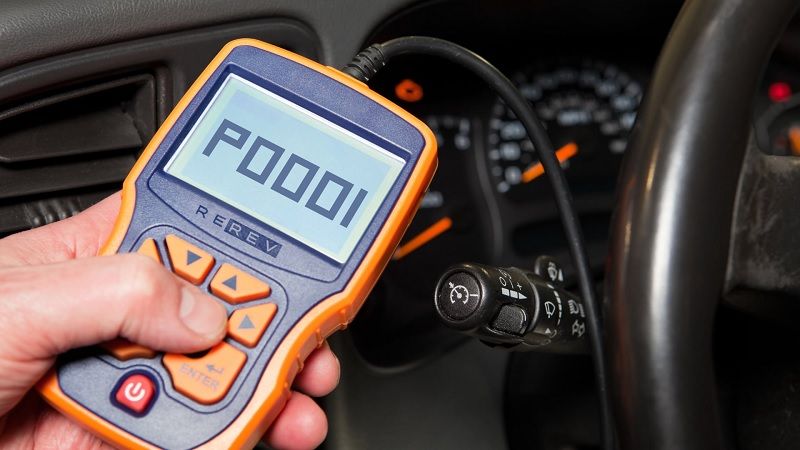This post contains affiliate links. This means I will make a commission at no extra cost to you should you click through and make a purchase [ “As an Amazon Associate, I earn from qualifying purchases.” ]. Read the full disclosure here.
What Causes a P0001 Code? – Demystifying the P0001 Code: Understanding its Causes and Implications GuideMechanic.Com In the realm of automotive diagnostics, the appearance of a check engine light can trigger a wave of concern among vehicle owners.
One of the numerous trouble codes that may illuminate this warning is the P0001 code. This code can be perplexing, as it points to potential issues with fuel volume regulation, fuel pressure, or fuel injection timing.
In this comprehensive guide, we’ll delve into the intricacies of the P0001 code, exploring its causes, implications, and the steps to address it effectively.
See Also: P0441-00 Range Rover
What Causes a P0001 Code?
Understanding the P0001 Code:

The P0001 code is part of the OBD-II (On-Board Diagnostics II) system, a standardized method for diagnosing and reporting vehicle issues. Specifically, P0001 indicates a problem in the fuel volume regulator control circuit/open.
This code is typically associated with fuel delivery issues, such as insufficient fuel pressure, incorrect fuel injection timing, or malfunctions in the fuel volume regulator control circuit.
Causes of the P0001 Code:
Malfunctioning Fuel Volume Regulator Control Circuit: The fuel volume regulator control circuit is responsible for regulating the fuel pressure delivered to the engine.
If this circuit malfunctions or becomes open, the PCM (Powertrain Control Module) may detect insufficient fuel pressure and trigger the P0001 code.
Faulty Fuel Volume Regulator:
The fuel volume regulator, also known as the fuel pressure regulator, is a component that maintains consistent fuel pressure in the fuel system. A faulty regulator can lead to fluctuations in fuel pressure, which may trigger the P0001 code.
Fuel Pump Issues:
The fuel pump is responsible for delivering fuel from the tank to the engine. If the fuel pump is failing or operating below optimal levels, it can result in inadequate fuel pressure and trigger the P0001 code.
Fuel Filter Clogging:

A clogged fuel filter can restrict the flow of fuel to the engine, leading to decreased fuel pressure and potential issues with fuel volume regulation. Over time, debris and contaminants can accumulate in the fuel filter, causing it to become clogged and triggering the P0001 code.
Wiring or Connector Problems:
Issues with the wiring or connectors associated with the fuel volume regulator control circuit can also trigger the P0001 code. Corrosion, damage, or loose connections can disrupt the electrical signals between components, leading to malfunctions in fuel volume regulation.
What Causes a P0001 Code?
Implications of the P0001 Code:
The P0001 code indicates potential issues with fuel volume regulation, which can have several implications for vehicle performance and reliability. These include:
See Also: 4l60e Transmission External Wiring Harness Diagram
Reduced Engine Performance:
Inadequate fuel pressure or improper fuel injection timing can lead to decreased engine performance, including reduced power output, rough idling, and hesitation during acceleration.
Poor Fuel Efficiency:
Fuel delivery issues can result in inefficient combustion, leading to decreased fuel efficiency and increased fuel consumption.
Increased Emissions:
Fuel-related problems can contribute to higher emissions of pollutants such as hydrocarbons (HC), carbon monoxide (CO), and nitrogen oxides (NOx), potentially causing environmental harm and triggering regulatory compliance issues.
What Causes a P0001 Code?
Steps to Address the P0001 Code:
Diagnose the Issue: When the P0001 code is detected, it’s essential to conduct a thorough diagnostic inspection to identify the underlying cause.
This may involve using a diagnostic scan tool to retrieve additional trouble codes and data from the vehicle’s PCM, as well as performing visual inspections and functional tests on relevant components.
Check Fuel Pressure:
Check out this BETOOLL Pro Fuel Injection Pressure Tester Kit Gauge 0-140 PSI

Verify fuel pressure using a fuel pressure gauge to ensure it meets the manufacturer’s specifications. If fuel pressure is below the recommended range, further investigation into the fuel system components, such as the fuel pump, fuel filter, and fuel volume regulator, may be necessary.
Inspect Wiring and Connectors:
Check the wiring harness and connectors associated with the fuel volume regulator control circuit for signs of damage, corrosion, or loose connections. Repair or replace any damaged components as needed to restore proper electrical conductivity.
Test Fuel Volume Regulator:
Test the fuel volume regulator to ensure it is functioning correctly. This may involve performing resistance tests, voltage checks, or functional tests according to the manufacturer’s specifications. Replace the regulator if it fails to meet the required parameters.
Address Fuel System Issues:
If other fuel system components, such as the fuel pump or fuel filter, are found to be faulty or compromised, repair or replace them as necessary to restore proper fuel delivery and pressure.
What Causes a P0001 Code?
Conclusion:
The P0001 code can be indicative of various fuel delivery issues, ranging from malfunctions in the fuel volume regulator control circuit to problems with fuel pressure and injection timing.
Understanding the potential causes and implications of this code is crucial for diagnosing and addressing the underlying issues effectively.
By conducting thorough diagnostic inspections and taking appropriate corrective actions, vehicle owners can ensure optimal performance, fuel efficiency, and reliability for their vehicles.
See Also: How do I fix code P0170?
- Catalytic Converter Cleaner Canadian Tire - April 10, 2025
- Catalytic Converter Cleaner Petrol - April 9, 2025
- Catalytic Converter Cleaner Walmart - April 9, 2025
